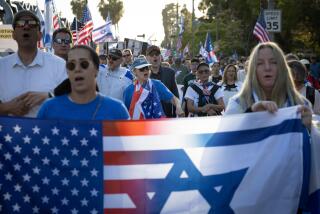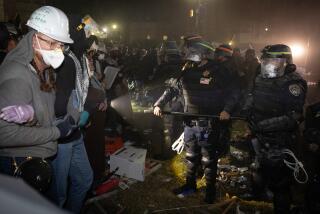Wartime Religion : Places of Worship See an Increase in Attendance as Fighting Begins
- Share via
When America went to war last month, it also went to worship.
Pews filled to their edges and people stood in the aisles at churches and synagogues as the country suddenly faced the specter of violent death half a world away. Across major religious denominations, the weekly faithful mixed with those who rarely attend or who had drifted away years ago.
For the record:
12:00 a.m. Feb. 22, 1991 For the Record
Los Angeles Times Friday February 22, 1991 Orange County Edition View Part E Page 2 Column 3 View Desk 1 inches; 29 words Type of Material: Correction
Pastor’s name--A photograph which appeared with a Wednesday story on war and religion misidentified the subject. The man leading a prayer at South Coast Community Church in Irvine was Pastor Don Johnson.
And the surge in attendance at religious services the weekend after the first allied bombs fell on Iraq apparently was not a transitory statistical blip. A month into a frightening and uncertain war, people continue to turn to religion in an attempt to find moral and spiritual resolution to the most basic of human issues: peace and war, life and death, right and wrong.
A Gallup Organization survey released last week revealed that 57% of Americans said they were “praying more than usual,” even in the days before the outbreak of the war.
Further, “surveys conducted shortly after the Jan. 15 deadline also showed higher percentages than usual saying that religion is ‘very important’ in their lives--62%,” said Gallup. This contrasted with an average of 55% in the 1980s who said that.
In Orange County, the attendance figures have been even more dramatic.
The Crystal Cathedral in Garden Grove has added a third Sunday service to handle overflow crowds of worshipers.
The normally large Sunday congregation at Mission Viejo’s Saddleback Valley Community Church has swelled with between 500 and 600 new churchgoers in excess of its usual complement of about 4,000, said Pastor Rick Warren. (Warren said he attended a meeting in Florida recently where pastors of the 25 churches with the largest congregations in the country reported that attendance at their churches jumped “universally, across the board” immediately after the start of war.)
At South Coast Community Church in Irvine, where the congregation usually numbers about 5,000 or more, there was a leap of about 1,400 people attending the three services there the Sunday after the war broke out, said Pastor Joseph Hemphill, and that number has risen since.
And, while there are no hard numbers, the Roman Catholic Diocese of Orange has seen an estimated rise in attendance at both daily and Sunday Masses of about 20%, said diocese spokesman Msgr. Lawrence Baird.
Other churches, such as St. Mark’s Presbyterian Church in Newport Beach, have only seen a handful of new faces in the pews on Sunday but report a greater seriousness of purpose and depth of feeling among the congregation.
“There’s more intensity,” said Gary Collins, pastor of St. Mark’s. “The prayers are more fervent.”
This intensity of feeling may be most visible among Jewish congregations, which have swelled dramatically since the days leading up to the war. Jewish religious leaders say that many Jews are returning to the synagogue not simply for religious reasons, but because the threat against Israel has deepened their sense of ethnicity, community and empathy with friends or relatives in Israel.
This sudden return to religion probably is not a simple knee-jerk reaction to war, but to a certain type of war, said Wade Clark Roof, professor of religion and society at UC Santa Barbara. While Roof said that attendance at religious services often is attendant on war, he said the magnitude and intensity of that phenomenon “depends on how the war is viewed.”
“Vietnam at one point tore this country apart,” said Roof, “but that war didn’t send people to churches the way some wars had. World War II was associated with a rise in church attendance, and it lasted after the war and gave rise to a so-called religious revival in the postwar era.”
So far, said Roof, the war in the Persian Gulf more closely resembles World War II in the effect it has had on church attendance. But there are no guarantees.
“This is a kind of God-and-country war,” said Roof, “which is scary in a way. It’s also open to a very possible quick turn, in which case it could come to look like a Vietnam situation. But we’re not there yet.”
Where we are, he said, is in a new and unique period of global uncertainty, and that uncertainty has been fanned into fear by the actions of Saddam Hussein.
“There’s something that is very different about this situation from the past,” said Roof. “Older people remember World War II, when Hitler was a very easy target. In Korea, communism was the easy target, and Vietnam to some extent was that way. But in the last couple of years, the old world order has become rather fragile, and we’re not sure who it is that America is engaged in competition with anymore. And suddenly we have this little upstart dictator in the Middle East and we have a target, but we’re not quite sure what he represents.”
The traditional bogeymen are gone, the new foe is frustrating and baffling and the theater in which the war is being fought is volatile and strange to many Americans, said Roof. And it all produces fear.
Feelings such as fear and uncertainty invariably drive people together. For many, this means church.
“The critical issue is one of dealing with anxiety and the unknown, and . . . that’s one of the central functions of religion,” said Jeffrey Hadden, a professor of sociology and an American church historian at the University of Virginia. “Religion provides meaning when meaning is otherwise elusive and provides a sense of comfort. War is not unlike death and sickness. People show up in church for funerals and go to pray when (there are) family tragedies when they otherwise don’t.”
War also can produce a kind of epiphany, a jolt to the instincts, that finds its outward expression in active religion, said Roof.
“It arouses a kind of primordial assertion of who we are and what we stand for and what we are fighting for,” he said. “Basically, what happens in wartime is that a country experiences something like what Emile Durkheim, the great sociologist of the last century, called ‘moments of effervescence.’ That’s a time when the social bonds get strengthened in a society. You feel drawn together by events external to that country. It’s a kind of affirmation or reaffirmation of basic beliefs, and it can tend to take a religious form. It shows up in a lot of flag-waving and patriotic music being sung in churches.”
Also, the Persian Gulf War carries with it a visceral immediacy not seen since Vietnam, thanks to television.
“We live in a society where death is sort of made antiseptic,” said Msgr. Baird. “I think that just the awareness brought to the public through the media--seeing the graphic activity of war--that perhaps has had an effect. Many people are fundamentally religious, but they may not externally express it until there is a catalyst for it.”
Which, say clerics and sociologists, is probably a fair description of the typical new face in the congregation. For the most part, they say, the increased numbers at services are made up of people returning to religion, not getting it for the first time--in effect, prodigal sons and daughters.
“Your pool of potential (congregation members) is going to almost always come from people who have been predisposed to religion or who were raised in it,” said Hadden.
Such a reaction may be particularly noticeable in the Catholic Church.
Baird said that “at the most, 60% of Catholics go to Mass on Sunday, and it’s probably considerably less than that. There are people who confine themselves to going at the high points in their lives: the sacraments, Christmas, Easter. Although the current increase (in attendance at Mass) isn’t quite equal to those times, it’s close, it seems to me. In conversations outside church on Sundays, it appears that there are people coming now who are Catholic and who ordinarily don’t go to Mass regularly.”
Said Roof: “It’s not as if they just found religion. My hunch is that people who don’t ever go to church probably aren’t going now. I think there are a lot of people who either have relatives in the gulf or know someone there. It’s a kind of networking, with X knowing Y and Y having a son there.”
Such ties to the Gulf region, by blood or friendship or heritage, are particularly strong in the Jewish community, where attendance at synagogue services has jumped significantly in the last month, said Rabbi Joseph Glaser.
Glaser, the executive vice president of the Central Conference of American Rabbis and the chairman of the board of Religion in American Life (an umbrella body for more than 50 national religious organizations), said he had been hearing of “capacity attendance at synagogues. I’m hearing all over that people are turning up in droves and calling rabbis and so forth. The synagogue that I belong to (in New York) . . . told me 1,300 people came to services Friday night and they ordinarily get maybe 150.”
At Shir Ha-Ma’Alot Harbor Reform Temple, which shares facilities in Newport Beach with St. Mark’s Presbyterian Church, attendance has been up almost a third since Jan. 17, said Rabbi Bernard King.
“Maybe the Jewish community senses a larger stake in this somehow because of having so many relatives and friends living in Israel in close proximity to the war,” said King. “It’s been fairly dramatic with us. The Jewish community is not just a community of faith, we’re also a kind of family, a people, an ethnic group. I believe that our people have this sense that they wanted to be together with other Jews during this time. In times of crisis, I think you tend to seek out your group as a family.”
But what happens when the crisis ends? Will the prodigals remain, having formed a new bond with their religion during wartime? For the most part, the answer probably is no.
“Oh, sure, you’ll get some residual impact,” said Hadden, “but in large measure people will cease to feel the need after a short while for that which stimulated then to draw upon the resource in the first place. The therapy will no longer be required.”
Said Baird: “It would be good if they would hang on, but the reality is that when a crisis passes we tend to go back to our old ways. Sometimes people don’t make a significant life change when the driving force for it is absent.”
Still, said Collins, full pews are probably only a single, outward indication of the country’s level of spirituality during time of war. And even if church attendance falls off again when the Gulf War is over, a significant feeling of new spirituality may remain for many.
“On a spiritual level, our growth is hidden,” said Collins. “I think (during times of crisis) we reach deeper and deeper levels of spirituality, even though our attendance at a religious function may or may not indicate what has happened to us spiritually. There’s a Chinese pictograph that indicates that every crisis is an opportunity as well. We may see the attendance fall off, but it will have been a time of inner growth. It’s impossible to know what’s happened inside, in terms of the person’s soul.”
More to Read
Sign up for Essential California
The most important California stories and recommendations in your inbox every morning.
You may occasionally receive promotional content from the Los Angeles Times.










